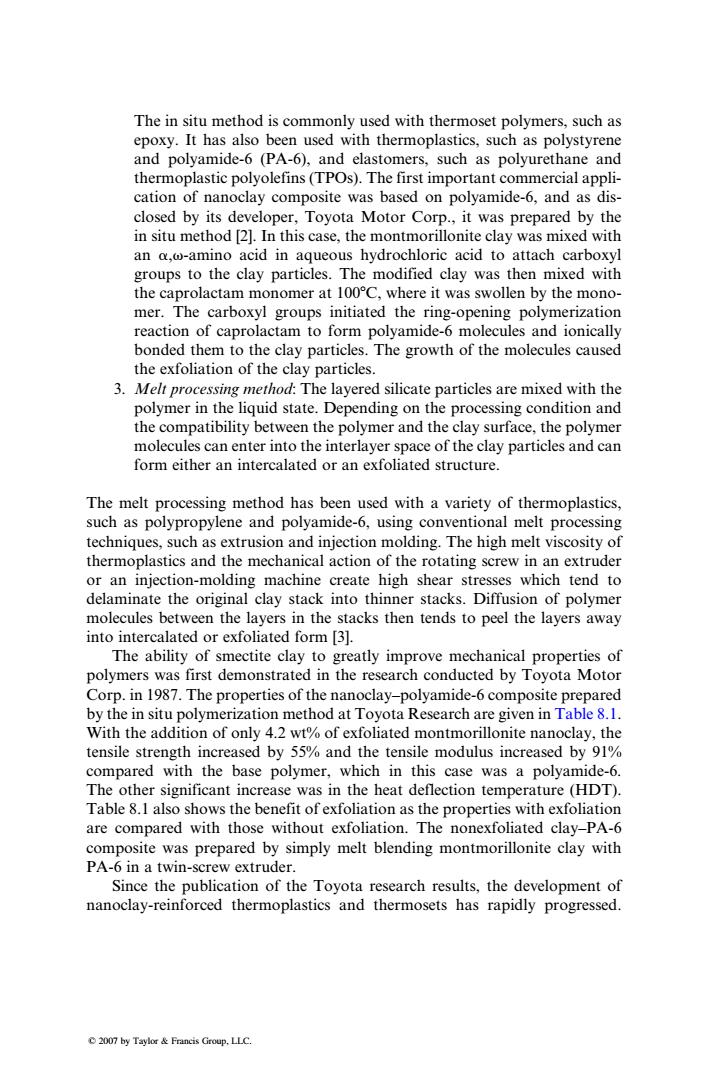正在加载图片...

The in situ method is commonly used with thermoset polymers,such as epoxy.It has also been used with thermoplastics,such as polystyrene and polyamide-6 (PA-6),and elastomers,such as polyurethane and thermoplastic polyolefins(TPOs).The first important commercial appli- cation of nanoclay composite was based on polyamide-6,and as dis- closed by its developer,Toyota Motor Corp.,it was prepared by the in situ method [2].In this case,the montmorillonite clay was mixed with an o,@-amino acid in aqueous hydrochloric acid to attach carboxyl groups to the clay particles.The modified clay was then mixed with the caprolactam monomer at 100C,where it was swollen by the mono- mer.The carboxyl groups initiated the ring-opening polymerization reaction of caprolactam to form polyamide-6 molecules and ionically bonded them to the clay particles.The growth of the molecules caused the exfoliation of the clay particles. 3.Melt processing method:The layered silicate particles are mixed with the polymer in the liquid state.Depending on the processing condition and the compatibility between the polymer and the clay surface,the polymer molecules can enter into the interlayer space of the clay particles and can form either an intercalated or an exfoliated structure. The melt processing method has been used with a variety of thermoplastics, such as polypropylene and polyamide-6,using conventional melt processing techniques,such as extrusion and injection molding.The high melt viscosity of thermoplastics and the mechanical action of the rotating screw in an extruder or an injection-molding machine create high shear stresses which tend to delaminate the original clay stack into thinner stacks.Diffusion of polymer molecules between the layers in the stacks then tends to peel the layers away into intercalated or exfoliated form [3]. The ability of smectite clay to greatly improve mechanical properties of polymers was first demonstrated in the research conducted by Toyota Motor Corp.in 1987.The properties of the nanoclay-polyamide-6 composite prepared by the in situ polymerization method at Toyota Research are given in Table 8.1. With the addition of only 4.2 wt%of exfoliated montmorillonite nanoclay,the tensile strength increased by 55%and the tensile modulus increased by 91% compared with the base polymer,which in this case was a polyamide-6. The other significant increase was in the heat deflection temperature (HDT). Table 8.1 also shows the benefit of exfoliation as the properties with exfoliation are compared with those without exfoliation.The nonexfoliated clay-PA-6 composite was prepared by simply melt blending montmorillonite clay with PA-6 in a twin-screw extruder. Since the publication of the Toyota research results,the development of nanoclay-reinforced thermoplastics and thermosets has rapidly progressed. 2007 by Taylor Francis Group,LLC.The in situ method is commonly used with thermoset polymers, such as epoxy. It has also been used with thermoplastics, such as polystyrene and polyamide-6 (PA-6), and elastomers, such as polyurethane and thermoplastic polyolefins (TPOs). The first important commercial application of nanoclay composite was based on polyamide-6, and as disclosed by its developer, Toyota Motor Corp., it was prepared by the in situ method [2]. In this case, the montmorillonite clay was mixed with an a,v-amino acid in aqueous hydrochloric acid to attach carboxyl groups to the clay particles. The modified clay was then mixed with the caprolactam monomer at 1008C, where it was swollen by the monomer. The carboxyl groups initiated the ring-opening polymerization reaction of caprolactam to form polyamide-6 molecules and ionically bonded them to the clay particles. The growth of the molecules caused the exfoliation of the clay particles. 3. Melt processing method: The layered silicate particles are mixed with the polymer in the liquid state. Depending on the processing condition and the compatibility between the polymer and the clay surface, the polymer molecules can enter into the interlayer space of the clay particles and can form either an intercalated or an exfoliated structure. The melt processing method has been used with a variety of thermoplastics, such as polypropylene and polyamide-6, using conventional melt processing techniques, such as extrusion and injection molding. The high melt viscosity of thermoplastics and the mechanical action of the rotating screw in an extruder or an injection-molding machine create high shear stresses which tend to delaminate the original clay stack into thinner stacks. Diffusion of polymer molecules between the layers in the stacks then tends to peel the layers away into intercalated or exfoliated form [3]. The ability of smectite clay to greatly improve mechanical properties of polymers was first demonstrated in the research conducted by Toyota Motor Corp. in 1987. The properties of the nanoclay–polyamide-6 composite prepared by the in situ polymerization method at Toyota Research are given in Table 8.1. With the addition of only 4.2 wt% of exfoliated montmorillonite nanoclay, the tensile strength increased by 55% and the tensile modulus increased by 91% compared with the base polymer, which in this case was a polyamide-6. The other significant increase was in the heat deflection temperature (HDT). Table 8.1 also shows the benefit of exfoliation as the properties with exfoliation are compared with those without exfoliation. The nonexfoliated clay–PA-6 composite was prepared by simply melt blending montmorillonite clay with PA-6 in a twin-screw extruder. Since the publication of the Toyota research results, the development of nanoclay-reinforced thermoplastics and thermosets has rapidly progressed. 2007 by Taylor & Francis Group, LLC